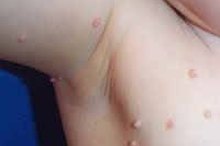How to Remove Moles With Glycolic Acid
A mole is a dark spot on the skin that can exist just below the skin or on top of the skin. While they often occur at birth, some develop later in life. Surgery and laser removal are two methods to remove moles from the skin; however, a less invasive treatment involves using glycolic acid 3. Moles that are the result of hyper-pigmentation can be diminished or removed with as few as five applications of glycolic acid. Although this treatment can be performed at home, the American Society of Plastic Surgeons advises that you schedule regular skin examinations to assess and diagnose neoplasms that could be linked to the mole 14.
Instructions
Combine 3.4 ounces of water and 3.4 ounces of glycolic acid in a bowl and stir until blended. Glycolic acid can be too harsh on the skin, which can lead to mild burns or skin inflammation. Dermatologists recommend diluting the acid in water to decrease the chance for skin irritation.
How to Get Rid of Stitch Scars on the Face
Learn More
Apply the mixture to the moles or hyperpigmented areas of your face.
Place the cotton pads over the moles and bandage. Covering the treated area allows the glycolic acid to penetrate the skin.
How to Treat Acne Cysts
Learn More
Allow the skin to remain covered for at least eight hours before removing the cotton bandages.
Repeat this procedure as needed for up to five days, until your moles or hyperpigmentation are less noticeable or disappear.
Tips
If your moles or hyperpigmentation do not respond to the treatment after five days, the American Society of Plastic Surgeons suggests seeking the advice of a licensed skin care professional for alternative treatment options.
Warnings
Glycolic acid can leave the skin susceptible to sun damage and skin irritation. For this reason, dermatologists recommend using a sunscreen or moisturizer with a SPF 15 following a glycolic peel. If you have sensitive skin or skin that is prone to sunburn, a sunscreen or moisturizer with an SPF of 20 or 25, according to the American Melanoma Foundation.
- Combine 3.4 ounces of water and 3.4 ounces of glycolic acid in a bowl and stir until blended.
- Repeat this procedure as needed for up to five days, until your moles or hyperpigmentation are less noticeable or disappear.
Related Articles
References
- American Society of Plastic Surgeons: Skin Cancer Surgery
- “Lookingbill and Marks' Principles of Dermatology”;James G. Marks Jr. MD and Jeffrey J. Miller MD; 2006
- Skin Tour: Moles, Lumps, and Bumps
- American Society of Plastic Surgeons: Skin Lesions
- National Institutes of Health PubChem. Glycolic acid. Updated February 1, 2020.
- Tang SC, Yang JH. Dual effects of alpha-hydroxy acids on the skin. Molecules. 2018;23(4):863. doi:10.3390/molecules23040863
- Fabbrocini G, Annunziata MC, D'Arco V, et al. Acne scars: pathogenesis, classification and treatment. Dermatol Res Pract. 2010;2010:893080. doi:10.1155/2010/893080
- U.S. Food and Drug Administration. Alpha hydroxy acids. Updated May 7, 2019.
- Al-Talib H, Al-Khateeb A, Hameed A, Murugaiah C. Efficacy and safety of superficial chemical peeling in treatment of active acne vulgaris. An Bras Dermatol. 2017;92(2):212–216. doi:10.1590/abd1806-4841.20175273
- Abels C, Reich H, Knie U, Werdier D, Lemmnitz G. Significant improvement in mild acne following a twice daily application for 6 weeks of an acidic cleansing product (pH 4). Journal of Cosmetic Dermatology. 2014;13(2):103-8. doi:0.1111/jocd.12086
- Kaminaka C, Uede M, Matsunaka H, Furukawa F, Yamomoto Y. Clinical evaluation of glycolic acid chemical peeling in patients with acne vulgaris: a randomized, double-blind, placebo-controlled, split-face comparative study. Dermatological Surgery. 2014;40(3):314-22. doi:10.1111/dsu.12417
- Sharad J. Glycolic acid peel therapy - a current review. Clinical Cosmetic and Investigational Dermatology. 2013;6:281-8. doi:10.2147/CCID.S34029
- Takenaka Y, Hayashi N, Takeda M, Ashikaga S, Kawashima M. Glycolic acid chemical peeling improves inflammatory acne eruptions through its inhibitory and bactericidal effects on Propionibacterium acnes. Journal of Dermatology. 2012;39(4):350-4. doi:10.1111/j.1346-8138.2011.01321.x
Writer Bio
Tennessee-based writer Davita Parks has been writing editorial, feature, business and health-related articles since 1998. Her work has appeared in magazines such as "African American Perspectives," "Showcase of Homes" and "Celebrate." Parks holds a Master of Science in mass communications from Arkansas State University.









